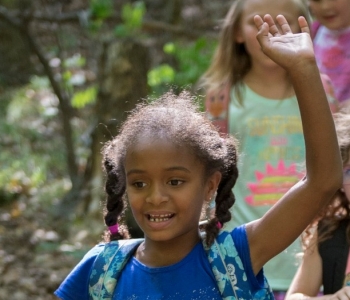Helping Your Girls Find Inspiration
Your troop’s community service or Take Action project should, of course, be girl-led; that is, your girls should decide on the project and take the necessary steps to bring it to life, but depending on their ages, you may need to help them hone their vision.
“We try to brainstorm as a group, starting with general interests and focusing on possible projects related to each topic, especially with the younger girls,” explains Silvia. “Start by looking at what issues they are more interested in—animals, children, literacy, the environment, or hunger, for instance—and generate a couple of ideas for each. Pretty soon, there are topics that seem to get most of the attention and ideas, and it becomes easier to focus on just that issue and develop a project.”
“For Journey Take Action projects, it is easy for the girls to get inspiration from what they learned in the Journey,” says Lara. “The older the girls are, the less guiding you need to do and the easier it can be.”
Some additional brainstorming methods could include:
- Asking the girls to look to their school, their town’s Main Street, or their favorite local park. Where can they make a difference?
- Asking the girls about stories they’re following in the news. How can they help people who live thousands of miles away? Similarly, ask the girls how an international story might translate locally.
- Reaching out to local Senior or Ambassador troops (or connecting with your council) and asking any Gold Award Girl Scouts to speak with your girls about their projects.
“The key is to guide them while not giving them your ideas but letting them come to conclusions on their own,” says Lara. “While their project may not be what you envisioned for them, if they came up with it, it is theirs. I've seen my girls do amazing things that I would never have thought of!"
Encourage your girls to learn more about the cause they're excited about—this may entail doing research as a team or meeting with someone involved in that issue, such as a volunteer coordinator at your local humane society, to get more information. If your troop decides to pursue a Take Action project, use our volunteer Take Action guide to simplify the planning stages.
Get Inspired by Our Volunteer Experts!
Community service
“One of my favorite community service projects began when our
community maintenance manager called up our troop leader and said we
have a donated trailer—one used to cook food for local festivals—and
you need to do something with it. From Thanksgiving to New Year’s Day
our community has a lights festival with decorations that dance to
music, and on the weekends, the trailer is set up for us and the girls
to hand out hot chocolate and collect food donations for the local
pantry. The girls have so much fun singing and dancing along with the
light displays!”
—Eileen Ryan, troop leader, Girl Scouts of
Greater Chicago and Northwest Indiana
Take Action
“When our girls were Juniors, they became aware of the large amount
of waste generated by juice pouches . . . so the girls decided to
start a juice pouch recycling program at the school. They talked to
the principal and the custodian, prepared and decorated a trash bin
with a slot just large enough for juice pouches to keep in the
cafeteria, and wrote letters to all teachers with information about
the project. For the first year of the program, they took turns each
week to empty the bin and prepare the [recycling], but they also got
the commitment of the younger troops at the school that as they each
reached fifth grade, they would be the ones in charge of continuing
the program. It was a proud moment, several years later, when they met
a younger troop at [a] swim party in which pouches were being
recycled, and one of the younger girls commented, ‘We recycle these at
my school, too.’”
—Silvia La Falce, Girl Scouts of Greater
Chicago and Northwest Indiana
By helping your girls find meaningful ways to give back, you also help them understand what it really means to live by the Girl Scout Law! Our volunteer experts will continue to share stories of guiding their girls through community service and Take Action projects.







